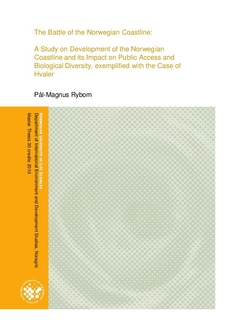| dc.description.abstract | For the last 40 years or so, the coastline southeast of Norway has changed dramatically when it comes to biological diversity, public access and esthetic appearance. Many of these less fortunate changes reflect a changing society, which now focus on development and privatization.
The coast is an enormous recreational resource, visited annually by tens of thousands, but as coastal development and growth continues, public access to these areas decrease. As a result, conflicts arise between coastal developers, private property owners, environmental organizations and the authorities were one side seeks to promote further development while the other fights for the protection of public access to the coastal shores and different fragile species that reside there.
In 1965 the Norwegian Government passed a legislation which prohibited further building activities from the water line and 100 meters into the land (the 100-meter belt). However, in order to uphold the individual municipality’s autonomy, it is possible to exempt from this law through dispensations or through regulations plans within municipality plans. The County Governor and the central government has the possibility to interfere with exemptions that conflict with Norwegian national guidelines and values, but research has led to believe that many county governors in Norway seldom use such measures.
This master thesis seeks out to explore why and how there has been increased building activity since the national legislation against building within the 100-meter belt in 1965 and furthermore explore the effects on biological diversity and public access. In order to investigate these issues the author has explored different pressure groups that either oppose or support such coastal development with attempts to determine their actual influential attributes by analyzing coastal legislations and institutions, and through relevant fieldwork.
The Hvaler archipelago, one of the most popular cabin communities and coastal recreational areas in Norway has been used as a case for this thesis. | en_US |
